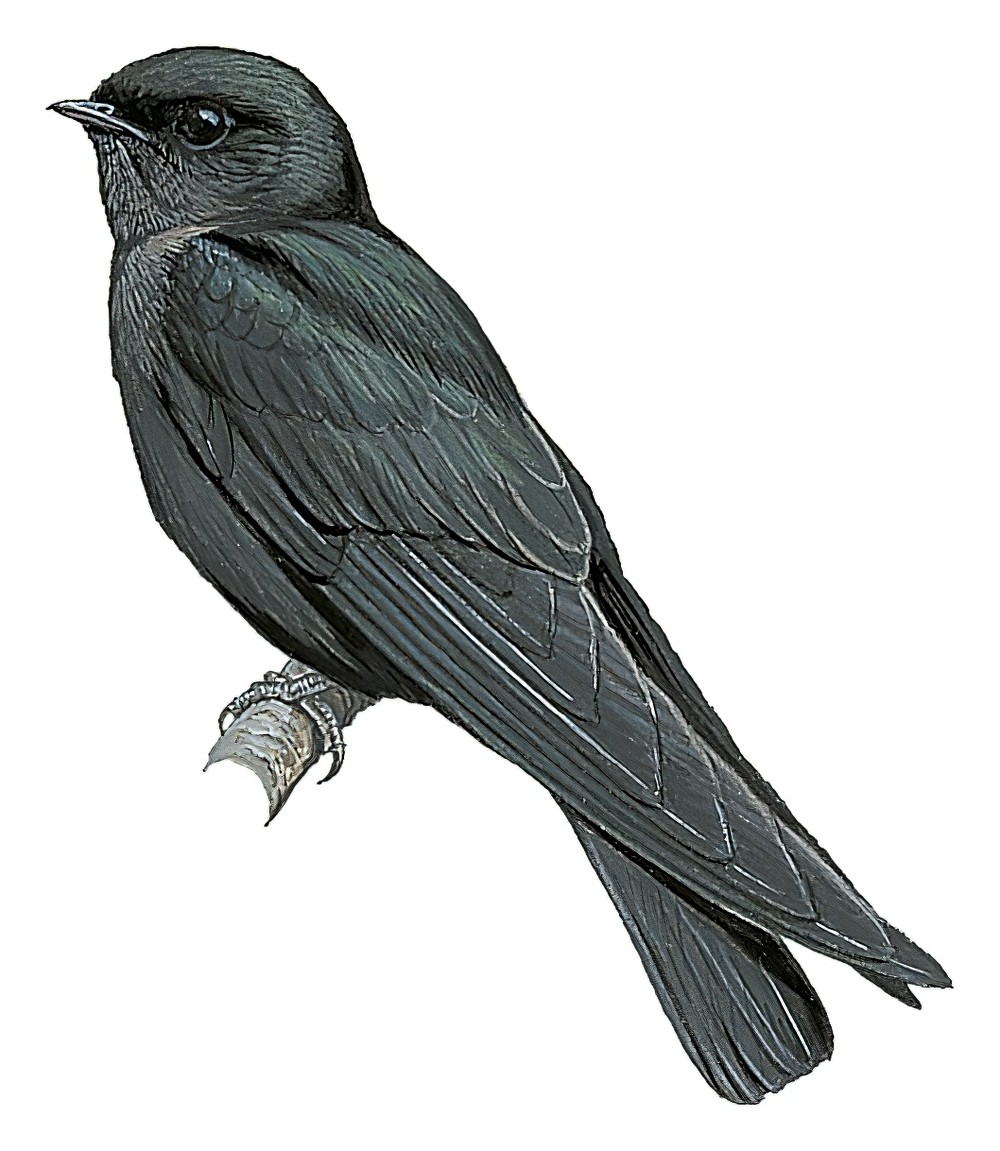Square-tailed Sawwing / Psalidoprocne nitens

Square-tailed Sawwing
SCI Name:
Protonym: Atticora nitens Proc.Acad.Nat.Sci.Philadelphia 9 p.38
Taxonomy: Passeriformes / Hirundinidae / Psalidoprocne
Taxonomy Code: sqtsaw1
Type Locality: Muni River, Gabon.
Author: Cassin
Publish Year: 1857
IUCN Status: Least Concern
DEFINITIONS
PSALIDOPROCNE
(Hirundinidae; Ϯ Black Saw-wing P. pristoptera holomelas) Gr. ψαλις psalis, ψαλιδος psalidos scissors; Gr. myth. Procne or Prokne, who was metamorphosed into a swallow (see Progne). In ornithology procne is used for both swallow and swift. "Gen. PSALIDOPROCNE nov. gen **) Scheerenschwalben. 302. 1. Ps. cypselina n. sp. ... **) Von ψαλισ, Scheere und Procne. — Der kleine Schnabel und das dunkle einfarbige Gefieder nähern diese Gattung scheinbar einigen Formen der Cypselinen, wogegen indess die Charaktere des Flügelbaues, die Zahl der Schwanzfedern und die Fussbildung streiten. Der Schwanz ist regelmässig und tief gegabelt, wie bei Atticora, Zehen und Nägel sind indess kürzer und schwächer als bei letzterer Gattung [Tachycineta] und ist die Aussenzehe kürzer als die innere Zehe. Der Typus der Gattung P cypselina ist einfarbig dunkelschwarzbraun oder schwärzlich und fast überall mit jenem matten schwarzgrünlichen Schiller versehen, welcher als charakteristisch bei mehreren Arten der Cypselinae, (wie z. B. an den Flügeln von Acanth. collaris) bemerkt wird. Der Zügel ist sammetschwarz; die untern Flügeldecken sind graubraun. Die Füsse hellbraun. Die Aussenfahne der 1sten Schwinge ist ähnlich gesägt wie bei einigen Arten von Cotyle (C. serripennis flavigastra etc.)." (Cabanis 1853); "Psalidoprocne Cabanis, 1850, Mus. Hein., Th. 1, 1850-51 [= 1853], p. 48. Type, by monotypy, Ps. cypselina Cabanis = Hirundo holomelas Sundevall." (Peters 1960, IX, 125).
Var. Psalidoprogne.
Synon. Pristoptera, Woltersia.
nitens
L. nitens, nitentis shining, glittering < nitere to shine, to glitter.
● ex “Glossy Finch” of Latham 1783 (syn. Hypochera chalybeata).
● ex “Merle vert d’Angola” of Brisson 1760 (Lamprotornis).
● ex “Green Fly-catcher” of Latham 1783 (unident.).
SUBSPECIES
Square-tailed Sawwing (nitens)
SCI Name: Psalidoprocne nitens nitens
nitens
L. nitens, nitentis shining, glittering < nitere to shine, to glitter.
● ex “Glossy Finch” of Latham 1783 (syn. Hypochera chalybeata).
● ex “Merle vert d’Angola” of Brisson 1760 (Lamprotornis).
● ex “Green Fly-catcher” of Latham 1783 (unident.).
Square-tailed Sawwing (centralis)
SCI Name: Psalidoprocne nitens centralis
centralis
L. centralis, centrale central, in the middle < centrum middle point, centre < Gr. κεντρον kentron sharp point, stationary point of a pair of compasses. A good proportion of the names here refer to forms collected in "Central Africa," i.e. the eastern Congo and the Rift Valley lakes (e.g. subsp. Bradypterus baboecala, subsp. Chlorocichla flaviventris, subsp. Malimbus rubricollis, subsp. Sarothrura pulchra, subsp. Turdus pelios). Some further examples follow.
• "Dieselbe steht in Bezug auf Grösse zwischen cardinalis und massaicus in der Mitte." (Neumann 1900) (subsp. Dendropicos fuscescens).
• "Distribution. Endemic to Peru on east Andean slope from Río Huallaga through Pasco to Junín west of the Río Ene and north of the Río Mantaro ... The scientific name reflects the range of this species near the geographic center of Peru." (Hosner et al. in M. Isler et al. 2020) (Grallaria).
• "Intermediate in size between N. f. flavicollis (Vieill.) and N. f. melanoxantha (Lcht.)" (Hellmayr 1907) (subsp. Hemithraupis flavicollis).
• "These birds are intermediate between N. famosa and N. cupreonitens, and resemble birds labelled by Neumann in the Tring Museum with the MS. name Nectarinia famosa centralis" (van Someren 1916) (subsp. Nectarinia famosa).
• "RANGE. —Eastern part of the central Solomon Islands (Kulambangra, New Georgia, Vangunu, and Gatukai)." (Mayr 1932) (subsp. Pachycephala pectoralis).
• "zentralbrasilianischen Hochlandes (Matto-grosso. S. Goyaz. N.-São Paulo. W.-Minas Geraës)" (Hellmayr 1920) (subsp. Ramphocelus carbo).
• "the Central American form is named CICCABA VIRGATA CENTRALIS, subsp. nov. ... Chivela, Oaxaca, Mexico." (Griscom 1929) (subsp. Strix virgata).
• "Tang- (Dang-) la Range, Central Tibet, Tang-la Pass" (Sushkin 1926) (subsp. Tetraogallus tibetanus).
UPPERCASE: current genus
Uppercase first letter: generic synonym
● and ● See: generic homonyms
lowercase: species and subspecies
●: early names, variants, mispellings
‡: extinct
†: type species
Gr.: ancient Greek
L.: Latin
<: derived from
syn: synonym of
/: separates historical and modern geographic names
ex: based on
TL: type locality
OD: original diagnosis (genus) or original description (species)












